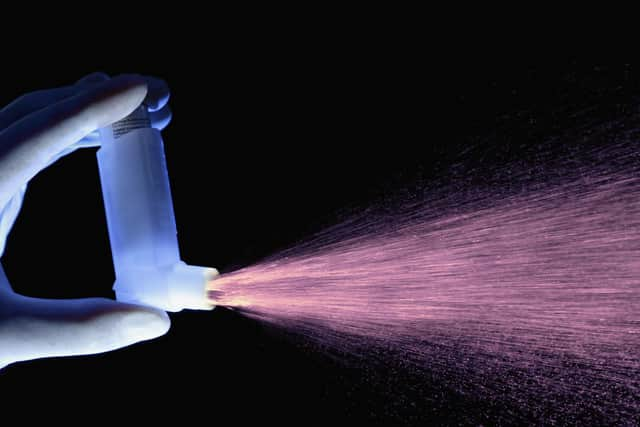Environment: Reduce our exposure to pollution if we walk or cycle rather than drive


This is important because some inhalers (called pressurised metered dose inhalers or pMDIs) contain powerful greenhouse gases approximately 1,500-3,000 times as powerful as carbon dioxide.
The effect on the environment of using one commonly prescribed pMDI(Ventolin) is similar to driving from Sheffield to London in an average car.
Advertisement
Hide AdAdvertisement
Hide AdIf you put a pMDI in the household waste it will either be burnt (but not at a temperature which is certain to destroy the greenhouse gases) or put in landfill where the greenhouse gases will gradually escape.


All medicines, especially inhalers, should be returned to any pharmacy to ensure they are incinerated at high enough temperatures. This is especially important for pMDI inhalers to ensure that greenhouse gases are fully broken down.
In the UK about 12% of us have been diagnosed as having asthma. There are high levels of air pollution in much of Sheffield, so there is likely to be even more asthma here as air pollution will both cause asthma (there is evidence that worldwide 13% of asthmatic people are asthmatic because of air pollution) and worsen asthma symptoms.
Air pollution is thought to be responsible for 36,000 deaths in the UK (over 300 a year in Sheffield) every year from a range of conditions, and is known to affect every organ of the body ranging from lung conditions, heart problems to dementia to diabetes.
Advertisement
Hide AdAdvertisement
Hide AdAction on air pollution is necessary at government level, but interestingly, we can also reduce our exposure to pollution if we walk or cycle compared to being in a car for the same journey.
Air pollution accumulates inside a car, increasing our exposure. It is also easier to use ginnels and smaller roads if you’re not in a car.
What about the diagnosis and treatment of asthma in the UK? Not only do a lot of people in the UK have asthma, but compared to the rest of Europe we have worse outcomes.
Nearly twice as many people die from asthma in the UK as in some other European countries, and the national review of these deaths in 2014 suggested at least 70% of our deaths were preventable.
Advertisement
Hide AdAdvertisement
Hide AdDr Aarti Bansal, a local Sheffield GP and the founder of Greener Practice, the UK’s primary care sustainability network, has been at the forefront of advocating for better and greener asthma care for patients.
She explains that both of these goals are about improving care and increasing patient choice.
The goal of asthma care is to be symptom-free with no restriction on activities. Unfortunately, many people with asthma continue to experience symptoms such as wheeze, cough and chest tightness and have avoidable asthma attacks.
Asthma treatment in the UK is dominated by pressurised metered dose inhalers (pMDIs), sometimes called puffers, which constitute approximately 70% of all the inhalers prescribed. Most of our European neighbours prescribe fewer than 50% MDIs and in Sweden the figure is 13%.
Advertisement
Hide AdAdvertisement
Hide AdMDIs have a very high carbon footprint because the canisters contain powerful propellant gases which are approximately 1000-3000 times more powerful than carbon dioxide.
These propellant gases are why MDIs are responsible for 13% of the carbon emissions that the NHS directly controls. Dry powder inhalers (DPIs) do not contain propellant gas and so have a vastly lower carbon footprint.
So which inhaler is best? This will be an individual decision for each patient with their healthcare professional.
Checking inhaler technique is a really good place to start, as good inhaler technique ensures that medicine gets into airways.
Advertisement
Hide AdAdvertisement
Hide AdIf you use an pMDI and you can feel or taste medicine at the back of your throat, it is not getting to where it is needed!One of the reasons that the UK has one of the highest asthma mortality rates in Europe is because so many people with asthma tend to rely on their reliever inhalers (usually blue) to manage their symptoms.
These inhalers are important whilst experiencing symptoms, as they temporarily open airways, but they do not treat the underlying airway inflammation and swelling. When inflamed airways encounter triggers (cold air, damp housing, air pollution, allergens, viral infections, smoke etc) they narrow further, causing symptoms and asthma attacks.
If people with asthma use 3 or more reliever inhalers a year, this is associated with a much higher risk of asthma attacks and hospitalisation.
Blue reliever inhalers do not treat the airway swelling that is the underlying problem in asthma. Inhaled corticosteroids (treatment or preventer inhalers), are the real treatment for asthma.
Advertisement
Hide AdAdvertisement
Hide AdTaken every day, as prescribed, they reduce the inflammation of the airway lining and prevent symptoms and asthma attacks.
Improving asthma control will save and improve lives, and people with asthma will need fewer reliever inhalers.
Reliever inhalers are responsible for more than 2/3rd of the inhaler carbon footprint, so this is better for patients and the planet.
Returning your used inhalers to pharmacists, who have an NHS contract to ensure their safe disposal, is a small contribution everybody who uses one can make to reduce the damaging impact of them on our environment.